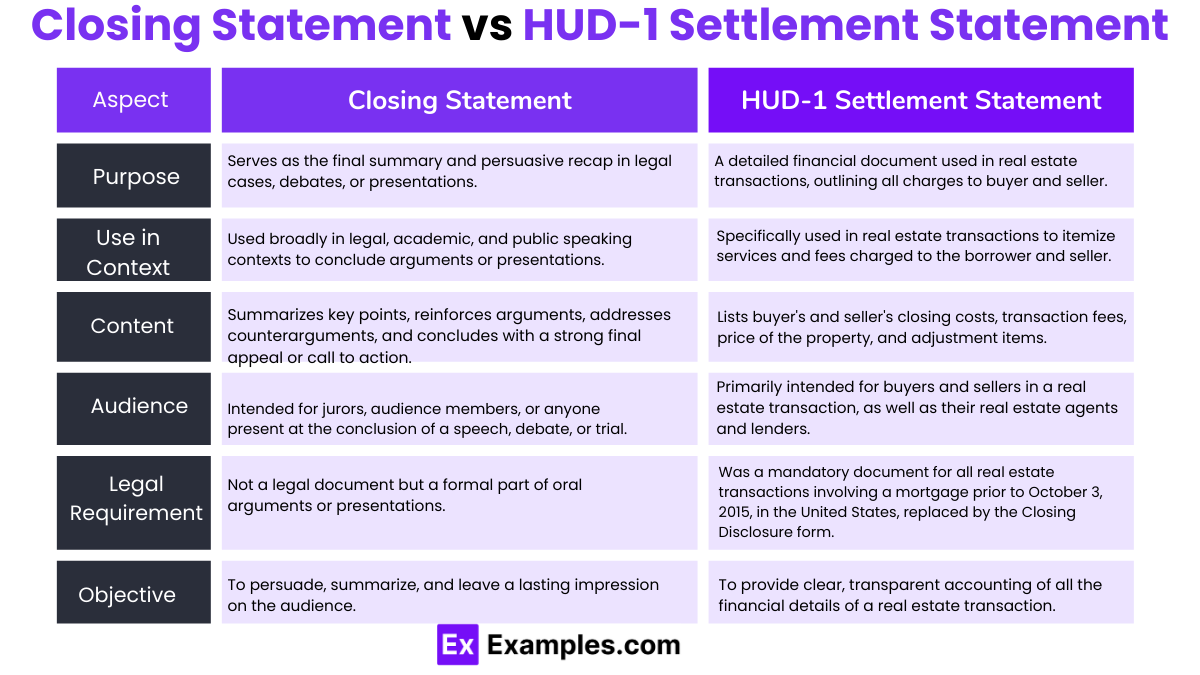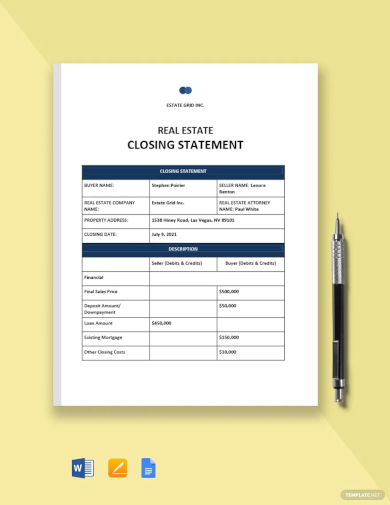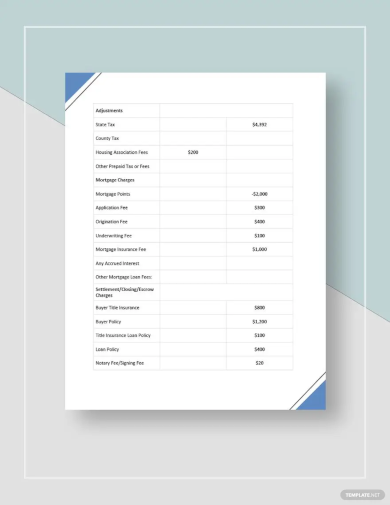9+ Closing Statement Examples to Download
In every formal occasion or any particular event, there is always that opening statement to welcome guests and participants. It allows the host to bring out a vibrant and lively spirit from everybody. However, another important part of an event is the closing ceremony. And it is imperative that you give a statement.
Whether your objective is to close the event with a happy or sad tone, it is up to you. The most important thing is that you properly close the occasion in a very memorable way. A personal statement would do as long as as it contains the essence of the affair.
What is a Closing Statement?
A closing statement is the final opportunity in a speech, debate, or legal trial for the speaker or attorney to summarize their position, reiterate key points, and make a lasting impression on the audience or jury. It’s designed to convincingly conclude the presentation of one’s case or argument, ideally swaying the outcome in their favor.
How to write a Closing Statement?
Writing a closing statement involves summarizing your arguments, reinforcing your main points, and leaving a lasting impression on your audience. Whether for a legal case, a debate, or a presentation, follow these steps to craft an effective closing statement:
1. Review Your Main Arguments
- Begin by revisiting the main points of your case or presentation. Identify the key arguments that are most compelling and supportive of your conclusion.
2. Outline Your Closing Statement
- Create an outline that logically organizes your final arguments. This should include an introduction that restates your thesis, a summary of key points, refutation of counterarguments, and a concluding appeal or call to action.
3. Restate Your Thesis or Position
- Open your closing statement by clearly restating your thesis or the position you are advocating for. This reminds your audience of the central issue at hand.
4. Summarize Key Points and Evidence
- Briefly recap the most persuasive points and evidence you presented. Highlight how this evidence supports your thesis, aiming to strengthen your argument in the minds of your audience.
5. Address and Refute Counterarguments
- Acknowledge any opposing viewpoints or evidence and provide a concise rebuttal. This demonstrates the thoroughness of your argument and your confidence in its validity.
6. Make an Emotional or Logical Appeal
- Depending on your audience and the nature of your argument, make a final appeal to emotion, logic, or ethics. Use storytelling, vivid imagery, or compelling facts to connect with your audience on a deeper level.
7. Conclude with a Strong Call to Action or Final Thought
- End your closing statement with a powerful call to action or a thought-provoking statement. This should encapsulate the essence of your argument and motivate your audience toward your desired outcome.
8. Practice Your Delivery
- If you will be delivering your closing statement orally, practice your delivery focusing on tone, pace, and body language. A confident and clear delivery can significantly enhance the impact of your words.
9. Review and Revise
- Review your closing statement for clarity, coherence, and impact. Make necessary revisions to ensure it is concise, persuasive, and leaves no room for doubt in your audience’s mind.
Structure of Closing Statement
- Greeting and Gratitude: Begin with a polite greeting and express gratitude towards the audience, jury, or judges for their attention.
- Restatement of Thesis/Position: Clearly restate the thesis or your main position to remind the audience of the core argument.
- Summary of Key Points: Succinctly summarize the main arguments or evidence presented, highlighting how they support your thesis.
- Refutation of Counterarguments: Briefly address and refute any counterarguments or opposing views to strengthen your position.
- Emotional Appeal: Include a personal story or an emotional appeal to humanize your argument and connect with the audience on a deeper level.
- Call to Action: Clearly state what you want the audience, jury, or judges to do or believe after hearing your statement.
- Closing Remarks:End with a powerful concluding sentence or phrase that encapsulates the essence of your argument and leaves a lasting impression.
- Thank You:Conclude by thanking the audience once again for their time and consideration.
Purpose of Closing Statement
The purpose of a closing statement encompasses several key objectives, each aimed at solidifying the speaker’s position and persuading the audience. Here are the main purposes outlined in points:
- Summarize the Argument: To concisely recap the main points or evidence presented, making the overall argument easier for the audience to remember and understand.
- Reinforce Key Messages: To emphasize the strongest parts of the argument or presentation, ensuring these elements are fresh in the audience’s mind.
- Address Counterarguments: To revisit and refute any counterarguments or opposition, strengthening the speaker’s position and credibility.
- Persuade the Audience: To sway the audience or jury towards the speaker’s viewpoint, using logical reasoning, emotional appeals, or ethical considerations.
- Provide a Clear Conclusion: To offer a definitive stance or resolution, leaving no ambiguity about the speaker’s position or recommended course of action.
- Call to Action: To motivate the audience towards a specific action or change in perspective, directly stemming from the argument’s conclusions.
- Leave a Lasting Impression: To conclude on a memorable note, ensuring the audience retains the core message and feels compelled to consider or act upon it.
Impact of Closing Statement
The impact of a closing statement, when well-crafted, can be profound and multifaceted. Here are some key points highlighting its significance:
- Persuasion: A compelling closing statement can sway the opinions of an audience or jury, tipping the scales in favor of the presenter’s argument or case.
- Memorability: It ensures that the core message and key points are memorable, leaving a lasting impression on the audience long after the speech or trial has concluded.
- Clarity: Provides a clear and concise summary of the arguments presented, helping the audience to understand the central thesis or the legal case’s merits.
- Emotional Engagement: By tapping into the emotions of the audience, a closing statement can forge a stronger connection, making the argument more impactful.
- Reinforcement of Evidence: It reinforces the evidence or key points presented throughout, solidifying the strength of the argument or case.
- Counteraction of Opposition: Addresses and counteracts any opposing arguments or evidence, reinforcing the presenter’s position as the more credible or persuasive one.
- Call to Action: A well-crafted closing statement can effectively motivate the audience to take a desired action or change their perspective on the issue.
Closing Statement vs HUD-1 Settlement Statement
| Aspect | Closing Statement | HUD-1 Settlement Statement |
|---|---|---|
| Purpose | Serves as the final summary and persuasive recap in legal cases, debates, or presentations. | A detailed financial document used in real estate transactions, outlining all charges to buyer and seller. |
| Use in Context | Used broadly in legal, academic, and public speaking contexts to conclude arguments or presentations. | Specifically used in real estate transactions to itemize services and fees charged to the borrower and seller. |
| Content | Summarizes key points, reinforces arguments, addresses counterarguments, and concludes with a strong final appeal or call to action. | Lists buyer’s and seller’s closing costs, transaction fees, price of the property, and adjustment items. |
| Audience | Intended for jurors, audience members, or anyone present at the conclusion of a speech, debate, or trial. | Primarily intended for buyers and sellers in a real estate transaction, as well as their real estate agents and lenders. |
| Legal Requirement | Not a legal document but a formal part of oral arguments or presentations. | Was a mandatory document for all real estate transactions involving a mortgage prior to October 3, 2015, in the United States, replaced by the Closing Disclosure form. |
| Objective | To persuade, summarize, and leave a lasting impression on the audience. | To provide clear, transparent accounting of all the financial details of a real estate transaction. |
What to Know before Drafting a Closing
Before drafting a closing statement, whether for a legal case, debate, presentation, or any other scenario where a persuasive summary is crucial, here are key points to consider:
- Understand Your Audience: Know the preferences, biases, and level of understanding of your audience. This knowledge will help tailor your closing to resonate and be persuasive.
- Reiterate Key Points: Identify the core arguments, evidence, and points you’ve presented. These should be the foundation of your closing, summarized clearly and compellingly.
- Address Counterarguments: Be prepared to refute any opposing views or counterarguments that have arisen. Showing how your arguments withstand criticism strengthens your position.
- Emotional Appeal: Consider the emotional aspects of your argument. An effective closing often includes an appeal to the audience’s emotions, making your final statement more impactful.
- Clear Call to Action: If applicable, include a specific call to action. Tell your audience exactly what you want them to think, feel, or do after hearing your statement.
- Structure and Flow: Plan a logical structure for your closing that starts strong, builds momentum, and ends with a powerful conclusion. A well-structured closing enhances understanding and retention.
- Practice Delivery: The impact of a closing statement can be significantly affected by how it’s delivered. Practice your tone, pace, and gestures to ensure they contribute positively to your message.
- Legal and Ethical Considerations: In legal contexts, ensure your closing statement complies with all relevant laws and ethical guidelines. Avoid making unsubstantiated claims or misrepresenting the evidence.
- Closing Visuals or Documents: If you’re using visual aids or documents (like a PowerPoint presentation or handouts), ensure they are clear, professional, and reinforce your message.
- Anticipate Questions or Reactions: Think ahead about potential questions or reactions from your audience. Being prepared will help you respond more effectively during or after your closing.
Real Estate Closing Statement Form Template
Real Estate Closing Statement Template
Informal Closing Statement
Real Estate Closing
Anatomy of Closing Statement
Landlord Tenant Closing
How to Start a Closing Statement
An effective statement is the one that could capture the hearts of the audience and stir their emotions. To start a closing statement, you need to put an emphasis on the objective statement or essence of the event. If the occasion is a wedding, remind the audience or listeners about love and how marriage should be guided by it.
Connect with the people by using emotional words or probably use lines from famous personalities. In addition to that, follow it up with some words of gratitude to everyone who joined and participated in the event. Do not forget to mention names of people who have contributed to the success of the event.
Is a Closing Statement the Same Thing as a Settlement Statement?
Before we answer this very intriguing question, let us first define what a settlement statement is. A settlement statement is a document that contains the summary of any relevant charges and fees in a transaction between a seller and a buyer particularly in a purchase of a property.
A closing statement, however, can be applied in various ways. It can be used to close an event or a transaction. It can be used as a speech. In truth, they are closely the same in consideration of its use in a business transaction. A closing statement can be used to close out any deals or agreements between a tenant and a landlord to settle any remaining debts and can be used in consolidation with an income statement.
Composite Closing Statement
Sworn Closing Statement
Draft Closing Sample
Seller Closing
How to Begin a Business Closing Statement
When you are dealing with business, it is always imperative that you should be professional. You have to use appropriate language with utmost formality like when you write a business statement. When you write a closing statement for a business, you need to bear in mind the main objective of the business.
What Does the Closing Statement Contain?
- Summary of Key Points: A concise recap of the most compelling arguments or evidence presented, emphasizing how they support the overall case or thesis.
- Refutation of Counterarguments: Addresses and counters any opposing views or arguments, reinforcing the strength and validity of the presenter’s position.
- Highlight of Evidence: A reminder of the pivotal pieces of evidence or testimony that significantly support the case, focusing on their impact and relevance.
- Emotional Appeal: Incorporates a strategic appeal to the audience’s emotions, aiming to connect on a human level and reinforce the moral or ethical righteousness of the presenter’s stance.
- Call to Action: Clearly defines what the speaker desires from the audience post-presentation, which could be a verdict, a change in perspective, or a specific action.
- Thanking the Audience: A polite acknowledgment of the audience’s time and attention, enhancing goodwill and leaving a positive impression.
- Strong Conclusion: A powerful and memorable closing line or paragraph that encapsulates the essence of the argument, designed to linger in the audience’s mind.
Final Word on Closing Statements
Closing statements are pivotal moments in any argumentative or persuasive context, encapsulating the essence of the argument, reinforcing key points, and leaving a lasting impression on the audience. An effective closing statement should summarize the presented evidence, address counterarguments, and clearly articulate the central thesis or call to action. It’s not just a summary but a final opportunity to persuade, engage, and influence the audience’s decision or perspective. The art of crafting a compelling closing lies in the ability to distill complex information into a clear, impactful message that resonates emotionally and intellectually with the audience. In essence, a well-delivered closing statement can be the deciding factor in swaying an audience, making it a crucial skill in legal practice, public speaking, and beyond.
Going Deeper: Ways to Improve the Closing Argument:
Improving the closing argument, whether in a legal case, debate, presentation, or any persuasive discourse, is essential for ensuring that your final appeal is compelling and effective. Here are strategies to enhance the impact of your closing argument:
1. Anchor on the Strongest Points
Focus on the most convincing evidence and arguments you have presented. Emphasize these points again in your closing to remind the audience of their significance and solidify your position.
2. Tell a Story
People remember stories far better than abstract arguments. Weave your points into a narrative that illustrates the impact, relevance, or truth of your argument. This approach can make your closing more engaging and memorable.
3. Appeal to Emotions Wisely
While logical arguments are crucial, an emotional appeal can be a powerful persuader. Connect with your audience on an emotional level by highlighting the human aspect of your argument but do so in a way that complements the logical foundation of your case.
4. Refute Counterarguments
Anticipate and address the strongest counterarguments that could undermine your position. Demonstrating how your argument withstands these challenges reinforces its strength and persuasiveness.
5. Use Repetition for Emphasis
Repetition can reinforce key themes and messages. Strategically repeating your most vital points in different ways helps ensure that your audience retains them.
6. Simplify Complex Ideas
Break down complex arguments into clear, understandable elements. A closing argument that is easy to follow is more likely to be convincing.
7. End with a Strong Call to Action
Be clear about what you want your audience to think, feel, or do after hearing your argument. A compelling call to action can motivate your audience towards the desired outcome.
8. Practice Delivery
The impact of your closing argument can be significantly affected by delivery. Practice your pacing, tone, and gestures to ensure they enhance rather than detract from your message.
9. Utilize Pauses Effectively
Strategic pauses can give your audience time to absorb important points and add dramatic effect to your delivery, making your argument more impactful.
10. Personalize Your Appeal
Make your closing argument relatable to your audience by personalizing your appeal. Showing how your argument directly affects or relates to your listeners can increase engagement and persuasion.
FAQs
What Do You Put in a Closing Statement?
A closing statement includes a summary of key points, a rebuttal to counterarguments, a final emotional or logical appeal, and a clear, compelling call to action or conclusion to reinforce your argument or standpoint.
What Is Another Name for a Closing Statement?
Another name for a closing statement is a “concluding argument” or “final argument,” both terms frequently used in legal contexts and public speaking to describe the last opportunity to persuade the audience.
Is a Closing Statement a Legal Document?
No, a closing statement is not a legal document. It is a verbal or written argument used in various contexts, including legal trials, debates, and presentations, to summarize and conclude an argument or case.
How Do You Write a Killer Closing Statement?
Writing a killer closing statement involves summarizing key points compellingly, addressing and refuting counterarguments, making a memorable final appeal, and ending with a strong, persuasive call to action or impactful statement.
What Is a Powerful Ending Statement?
A powerful ending statement is a memorable and impactful conclusion that resonates with the audience, reinforcing the speaker’s message and leaving a lasting impression that encourages reflection or action.
What Does a Closing Statement Look Like?
A closing statement typically looks like a structured summary that revisits the main arguments, counters opposing views, emphasizes the strongest points, and concludes with a powerful, final message or call to action.
What Can’t You Say in a Closing Statement?
In a closing statement, you should avoid introducing new evidence, making personal attacks, straying from the facts or evidence presented, or using disrespectful or unprofessional language.
What Is a Good Closing Statement for a Letter?
A good closing statement for a letter is courteous and reflects the tone of the letter, such as “Sincerely,” for formal letters, or “Best regards,” for less formal correspondence, followed by your name.
This allows you to recall the most important points and once again put an emphasis on it. The reason for this is that in a business dealing, there is a certainty that you will encounter a lot of ideas. So it is important to highlight the important ones on the closing statement.
9+ Closing Statement Examples to Download
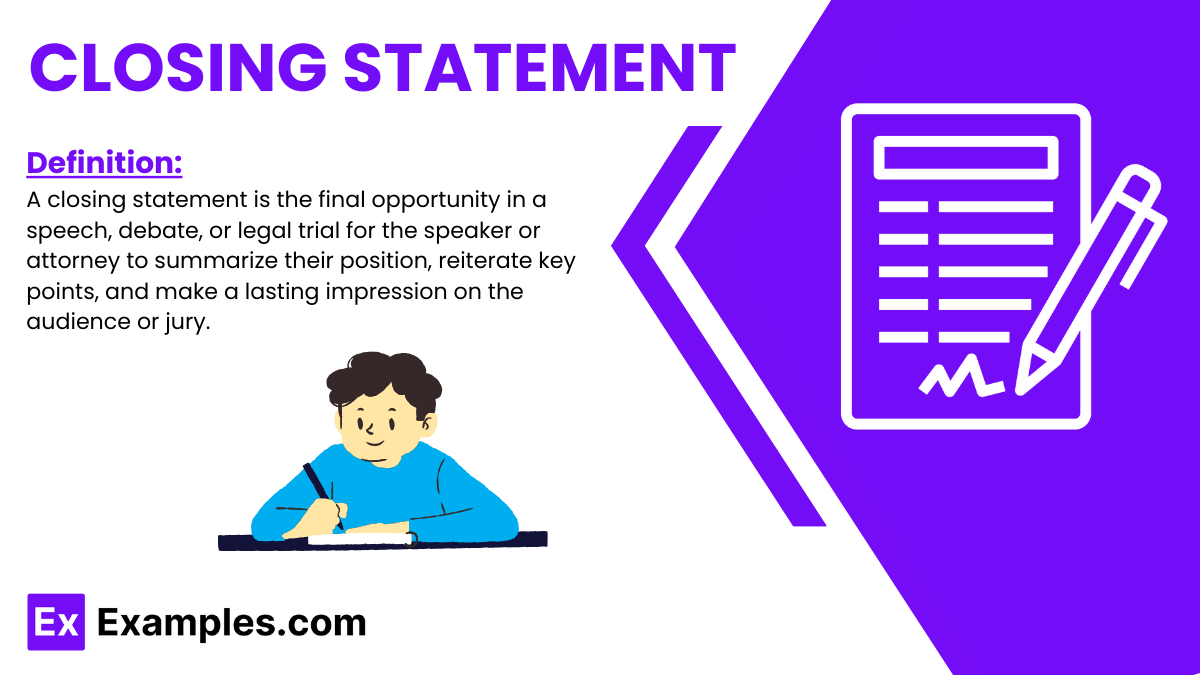
In every formal occasion or any particular event, there is always that opening statement to welcome guests and participants. It allows the host to bring out a vibrant and lively spirit from everybody. However, another important part of an event is the closing ceremony. And it is imperative that you give a statement.
Whether your objective is to close the event with a happy or sad tone, it is up to you. The most important thing is that you properly close the occasion in a very memorable way. A personal statement would do as long as as it contains the essence of the affair.
What is a Closing Statement?
A closing statement is the final opportunity in a speech, debate, or legal trial for the speaker or attorney to summarize their position, reiterate key points, and make a lasting impression on the audience or jury. It’s designed to convincingly conclude the presentation of one’s case or argument, ideally swaying the outcome in their favor.
How to write a Closing Statement?
Writing a closing statement involves summarizing your arguments, reinforcing your main points, and leaving a lasting impression on your audience. Whether for a legal case, a debate, or a presentation, follow these steps to craft an effective closing statement:
1. Review Your Main Arguments
Begin by revisiting the main points of your case or presentation. Identify the key arguments that are most compelling and supportive of your conclusion.
2. Outline Your Closing Statement
Create an outline that logically organizes your final arguments. This should include an introduction that restates your thesis, a summary of key points, refutation of counterarguments, and a concluding appeal or call to action.
3. Restate Your Thesis or Position
Open your closing statement by clearly restating your thesis or the position you are advocating for. This reminds your audience of the central issue at hand.
4. Summarize Key Points and Evidence
Briefly recap the most persuasive points and evidence you presented. Highlight how this evidence supports your thesis, aiming to strengthen your argument in the minds of your audience.
5. Address and Refute Counterarguments
Acknowledge any opposing viewpoints or evidence and provide a concise rebuttal. This demonstrates the thoroughness of your argument and your confidence in its validity.
6. Make an Emotional or Logical Appeal
Depending on your audience and the nature of your argument, make a final appeal to emotion, logic, or ethics. Use storytelling, vivid imagery, or compelling facts to connect with your audience on a deeper level.
7. Conclude with a Strong Call to Action or Final Thought
End your closing statement with a powerful call to action or a thought-provoking statement. This should encapsulate the essence of your argument and motivate your audience toward your desired outcome.
8. Practice Your Delivery
If you will be delivering your closing statement orally, practice your delivery focusing on tone, pace, and body language. A confident and clear delivery can significantly enhance the impact of your words.
9. Review and Revise
Review your closing statement for clarity, coherence, and impact. Make necessary revisions to ensure it is concise, persuasive, and leaves no room for doubt in your audience’s mind.
Structure of Closing Statement
Greeting and Gratitude: Begin with a polite greeting and express gratitude towards the audience, jury, or judges for their attention.
Restatement of Thesis/Position: Clearly restate the thesis or your main position to remind the audience of the core argument.
Summary of Key Points: Succinctly summarize the main arguments or evidence presented, highlighting how they support your thesis.
Refutation of Counterarguments: Briefly address and refute any counterarguments or opposing views to strengthen your position.
Emotional Appeal: Include a personal story or an emotional appeal to humanize your argument and connect with the audience on a deeper level.
Call to Action: Clearly state what you want the audience, jury, or judges to do or believe after hearing your statement.
Closing Remarks:End with a powerful concluding sentence or phrase that encapsulates the essence of your argument and leaves a lasting impression.
Thank You:Conclude by thanking the audience once again for their time and consideration.
Purpose of Closing Statement
The purpose of a closing statement encompasses several key objectives, each aimed at solidifying the speaker’s position and persuading the audience. Here are the main purposes outlined in points:
Summarize the Argument: To concisely recap the main points or evidence presented, making the overall argument easier for the audience to remember and understand.
Reinforce Key Messages: To emphasize the strongest parts of the argument or presentation, ensuring these elements are fresh in the audience’s mind.
Address Counterarguments: To revisit and refute any counterarguments or opposition, strengthening the speaker’s position and credibility.
Persuade the Audience: To sway the audience or jury towards the speaker’s viewpoint, using logical reasoning, emotional appeals, or ethical considerations.
Provide a Clear Conclusion: To offer a definitive stance or resolution, leaving no ambiguity about the speaker’s position or recommended course of action.
Call to Action: To motivate the audience towards a specific action or change in perspective, directly stemming from the argument’s conclusions.
Leave a Lasting Impression: To conclude on a memorable note, ensuring the audience retains the core message and feels compelled to consider or act upon it.
Impact of Closing Statement
The impact of a closing statement, when well-crafted, can be profound and multifaceted. Here are some key points highlighting its significance:
Persuasion: A compelling closing statement can sway the opinions of an audience or jury, tipping the scales in favor of the presenter’s argument or case.
Memorability: It ensures that the core message and key points are memorable, leaving a lasting impression on the audience long after the speech or trial has concluded.
Clarity: Provides a clear and concise summary of the arguments presented, helping the audience to understand the central thesis or the legal case’s merits.
Emotional Engagement: By tapping into the emotions of the audience, a closing statement can forge a stronger connection, making the argument more impactful.
Reinforcement of Evidence: It reinforces the evidence or key points presented throughout, solidifying the strength of the argument or case.
Counteraction of Opposition: Addresses and counteracts any opposing arguments or evidence, reinforcing the presenter’s position as the more credible or persuasive one.
Call to Action: A well-crafted closing statement can effectively motivate the audience to take a desired action or change their perspective on the issue.
Closing Statement vs HUD-1 Settlement Statement
Aspect | Closing Statement | HUD-1 Settlement Statement |
|---|---|---|
Purpose | Serves as the final summary and persuasive recap in legal cases, debates, or presentations. | A detailed financial document used in real estate transactions, outlining all charges to buyer and seller. |
Use in Context | Used broadly in legal, academic, and public speaking contexts to conclude arguments or presentations. | Specifically used in real estate transactions to itemize services and fees charged to the borrower and seller. |
Content | Summarizes key points, reinforces arguments, addresses counterarguments, and concludes with a strong final appeal or call to action. | Lists buyer’s and seller’s closing costs, transaction fees, price of the property, and adjustment items. |
Audience | Intended for jurors, audience members, or anyone present at the conclusion of a speech, debate, or trial. | Primarily intended for buyers and sellers in a real estate transaction, as well as their real estate agents and lenders. |
Legal Requirement | Not a legal document but a formal part of oral arguments or presentations. | Was a mandatory document for all real estate transactions involving a mortgage prior to October 3, 2015, in the United States, replaced by the Closing Disclosure form. |
Objective | To persuade, summarize, and leave a lasting impression on the audience. | To provide clear, transparent accounting of all the financial details of a real estate transaction. |
What to Know before Drafting a Closing
Before drafting a closing statement, whether for a legal case, debate, presentation, or any other scenario where a persuasive summary is crucial, here are key points to consider:
Understand Your Audience: Know the preferences, biases, and level of understanding of your audience. This knowledge will help tailor your closing to resonate and be persuasive.
Reiterate Key Points: Identify the core arguments, evidence, and points you’ve presented. These should be the foundation of your closing, summarized clearly and compellingly.
Address Counterarguments: Be prepared to refute any opposing views or counterarguments that have arisen. Showing how your arguments withstand criticism strengthens your position.
Emotional Appeal: Consider the emotional aspects of your argument. An effective closing often includes an appeal to the audience’s emotions, making your final statement more impactful.
Clear Call to Action: If applicable, include a specific call to action. Tell your audience exactly what you want them to think, feel, or do after hearing your statement.
Structure and Flow: Plan a logical structure for your closing that starts strong, builds momentum, and ends with a powerful conclusion. A well-structured closing enhances understanding and retention.
Practice Delivery: The impact of a closing statement can be significantly affected by how it’s delivered. Practice your tone, pace, and gestures to ensure they contribute positively to your message.
Legal and Ethical Considerations: In legal contexts, ensure your closing statement complies with all relevant laws and ethical guidelines. Avoid making unsubstantiated claims or misrepresenting the evidence.
Closing Visuals or Documents: If you’re using visual aids or documents (like a PowerPoint presentation or handouts), ensure they are clear, professional, and reinforce your message.
Anticipate Questions or Reactions: Think ahead about potential questions or reactions from your audience. Being prepared will help you respond more effectively during or after your closing.
Real Estate Closing Statement Form Template
Real Estate Closing Statement Template
Informal Closing Statement

unog.ch
Real Estate Closing
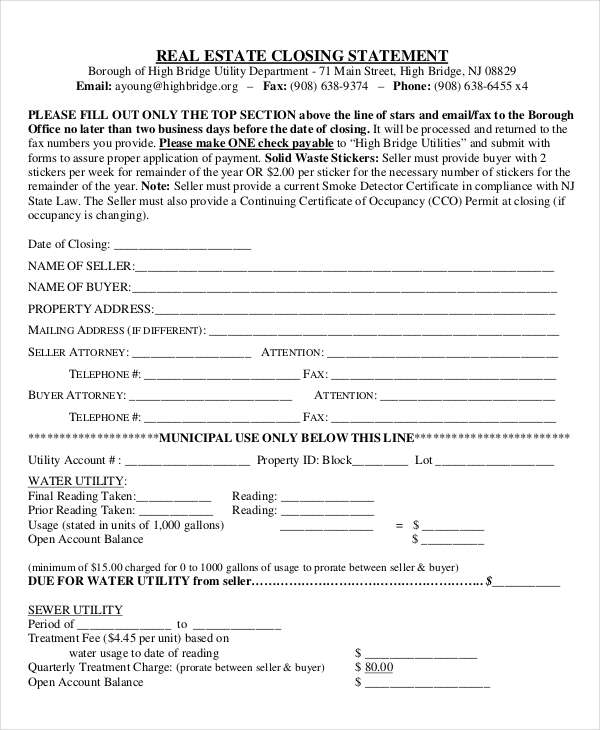
highbridge.org
Anatomy of Closing Statement
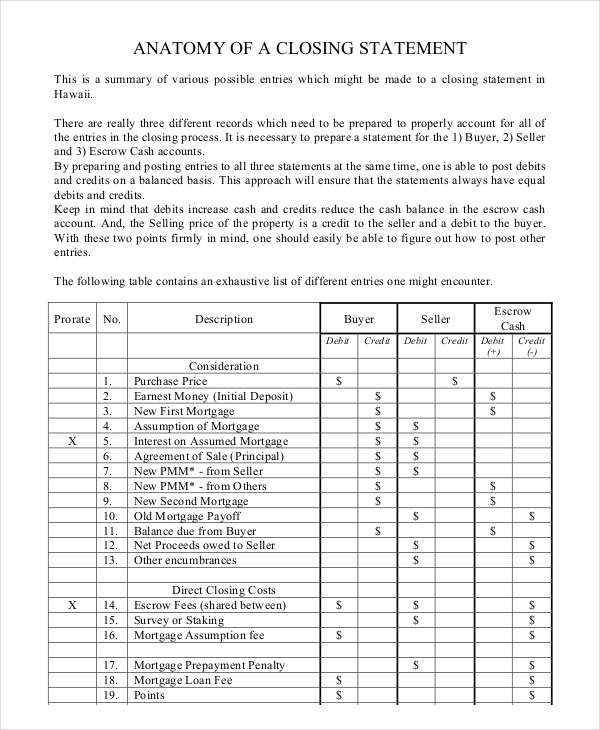
hawaii.gov
Landlord Tenant Closing
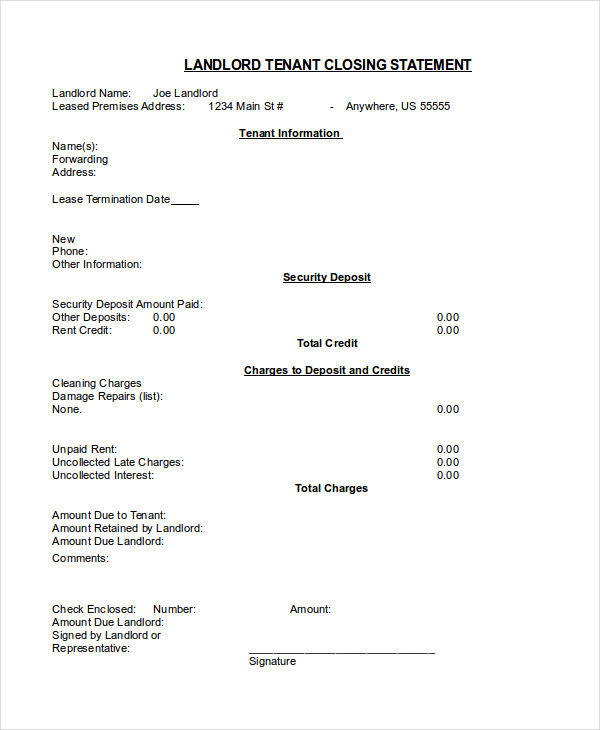
squarespace.com
How to Start a Closing Statement
An effective statement is the one that could capture the hearts of the audience and stir their emotions. To start a closing statement, you need to put an emphasis on the objective statement or essence of the event. If the occasion is a wedding, remind the audience or listeners about love and how marriage should be guided by it.
Connect with the people by using emotional words or probably use lines from famous personalities. In addition to that, follow it up with some words of gratitude to everyone who joined and participated in the event. Do not forget to mention names of people who have contributed to the success of the event.
Is a Closing Statement the Same Thing as a Settlement Statement?
Before we answer this very intriguing question, let us first define what a settlement statement is. A settlement statement is a document that contains the summary of any relevant charges and fees in a transaction between a seller and a buyer particularly in a purchase of a property.
A closing statement, however, can be applied in various ways. It can be used to close an event or a transaction. It can be used as a speech. In truth, they are closely the same in consideration of its use in a business transaction. A closing statement can be used to close out any deals or agreements between a tenant and a landlord to settle any remaining debts and can be used in consolidation with an income statement.
Composite Closing Statement
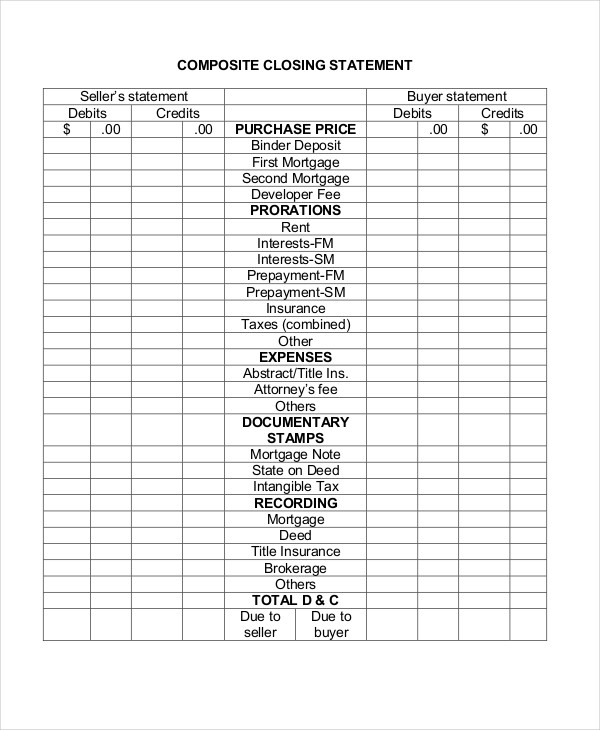
mckissock.com
Sworn Closing Statement
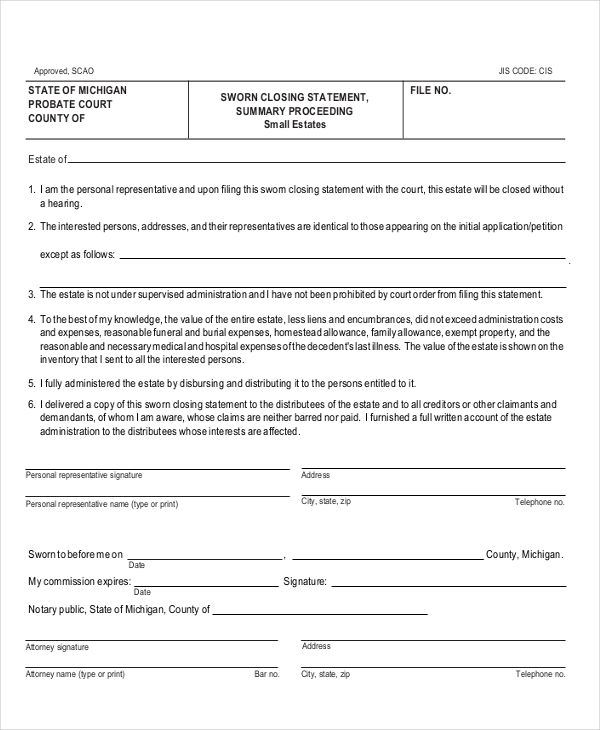
courts.mi.gov
Draft Closing Sample

un.org
Seller Closing
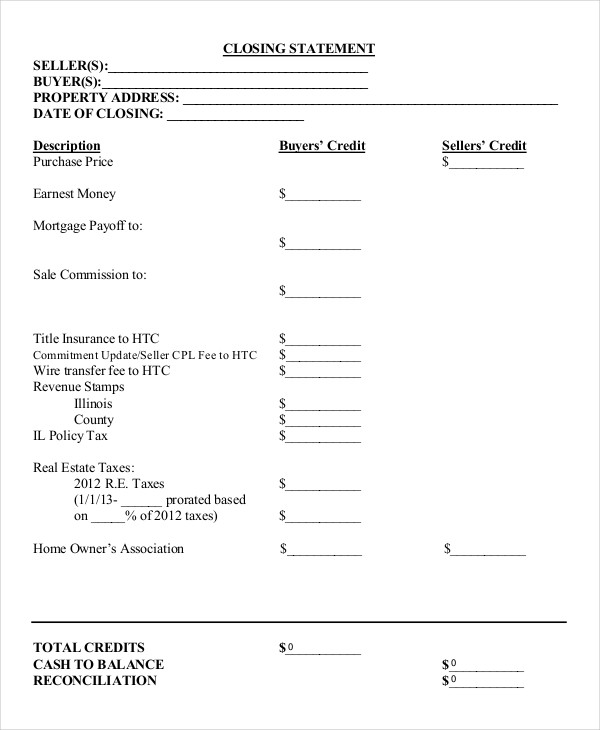
htc24x7.com
How to Begin a Business Closing Statement
When you are dealing with business, it is always imperative that you should be professional. You have to use appropriate language with utmost formality like when you write a business statement. When you write a closing statement for a business, you need to bear in mind the main objective of the business.
What Does the Closing Statement Contain?
Summary of Key Points: A concise recap of the most compelling arguments or evidence presented, emphasizing how they support the overall case or thesis.
Refutation of Counterarguments: Addresses and counters any opposing views or arguments, reinforcing the strength and validity of the presenter’s position.
Highlight of Evidence: A reminder of the pivotal pieces of evidence or testimony that significantly support the case, focusing on their impact and relevance.
Emotional Appeal: Incorporates a strategic appeal to the audience’s emotions, aiming to connect on a human level and reinforce the moral or ethical righteousness of the presenter’s stance.
Call to Action: Clearly defines what the speaker desires from the audience post-presentation, which could be a verdict, a change in perspective, or a specific action.
Thanking the Audience: A polite acknowledgment of the audience’s time and attention, enhancing goodwill and leaving a positive impression.
Strong Conclusion: A powerful and memorable closing line or paragraph that encapsulates the essence of the argument, designed to linger in the audience’s mind.
Final Word on Closing Statements
Closing statements are pivotal moments in any argumentative or persuasive context, encapsulating the essence of the argument, reinforcing key points, and leaving a lasting impression on the audience. An effective closing statement should summarize the presented evidence, address counterarguments, and clearly articulate the central thesis or call to action. It’s not just a summary but a final opportunity to persuade, engage, and influence the audience’s decision or perspective. The art of crafting a compelling closing lies in the ability to distill complex information into a clear, impactful message that resonates emotionally and intellectually with the audience. In essence, a well-delivered closing statement can be the deciding factor in swaying an audience, making it a crucial skill in legal practice, public speaking, and beyond.
Going Deeper: Ways to Improve the Closing Argument:
Improving the closing argument, whether in a legal case, debate, presentation, or any persuasive discourse, is essential for ensuring that your final appeal is compelling and effective. Here are strategies to enhance the impact of your closing argument:
1. Anchor on the Strongest Points
Focus on the most convincing evidence and arguments you have presented. Emphasize these points again in your closing to remind the audience of their significance and solidify your position.
2. Tell a Story
People remember stories far better than abstract arguments. Weave your points into a narrative that illustrates the impact, relevance, or truth of your argument. This approach can make your closing more engaging and memorable.
3. Appeal to Emotions Wisely
While logical arguments are crucial, an emotional appeal can be a powerful persuader. Connect with your audience on an emotional level by highlighting the human aspect of your argument but do so in a way that complements the logical foundation of your case.
4. Refute Counterarguments
Anticipate and address the strongest counterarguments that could undermine your position. Demonstrating how your argument withstands these challenges reinforces its strength and persuasiveness.
5. Use Repetition for Emphasis
Repetition can reinforce key themes and messages. Strategically repeating your most vital points in different ways helps ensure that your audience retains them.
6. Simplify Complex Ideas
Break down complex arguments into clear, understandable elements. A closing argument that is easy to follow is more likely to be convincing.
7. End with a Strong Call to Action
Be clear about what you want your audience to think, feel, or do after hearing your argument. A compelling call to action can motivate your audience towards the desired outcome.
8. Practice Delivery
The impact of your closing argument can be significantly affected by delivery. Practice your pacing, tone, and gestures to ensure they enhance rather than detract from your message.
9. Utilize Pauses Effectively
Strategic pauses can give your audience time to absorb important points and add dramatic effect to your delivery, making your argument more impactful.
10. Personalize Your Appeal
Make your closing argument relatable to your audience by personalizing your appeal. Showing how your argument directly affects or relates to your listeners can increase engagement and persuasion.
FAQs
What Do You Put in a Closing Statement?
A closing statement includes a summary of key points, a rebuttal to counterarguments, a final emotional or logical appeal, and a clear, compelling call to action or conclusion to reinforce your argument or standpoint.
What Is Another Name for a Closing Statement?
Another name for a closing statement is a “concluding argument” or “final argument,” both terms frequently used in legal contexts and public speaking to describe the last opportunity to persuade the audience.
Is a Closing Statement a Legal Document?
No, a closing statement is not a legal document. It is a verbal or written argument used in various contexts, including legal trials, debates, and presentations, to summarize and conclude an argument or case.
How Do You Write a Killer Closing Statement?
Writing a killer closing statement involves summarizing key points compellingly, addressing and refuting counterarguments, making a memorable final appeal, and ending with a strong, persuasive call to action or impactful statement.
What Is a Powerful Ending Statement?
A powerful ending statement is a memorable and impactful conclusion that resonates with the audience, reinforcing the speaker’s message and leaving a lasting impression that encourages reflection or action.
What Does a Closing Statement Look Like?
A closing statement typically looks like a structured summary that revisits the main arguments, counters opposing views, emphasizes the strongest points, and concludes with a powerful, final message or call to action.
What Can’t You Say in a Closing Statement?
In a closing statement, you should avoid introducing new evidence, making personal attacks, straying from the facts or evidence presented, or using disrespectful or unprofessional language.
What Is a Good Closing Statement for a Letter?
A good closing statement for a letter is courteous and reflects the tone of the letter, such as “Sincerely,” for formal letters, or “Best regards,” for less formal correspondence, followed by your name.
This allows you to recall the most important points and once again put an emphasis on it. The reason for this is that in a business dealing, there is a certainty that you will encounter a lot of ideas. So it is important to highlight the important ones on the closing statement.


